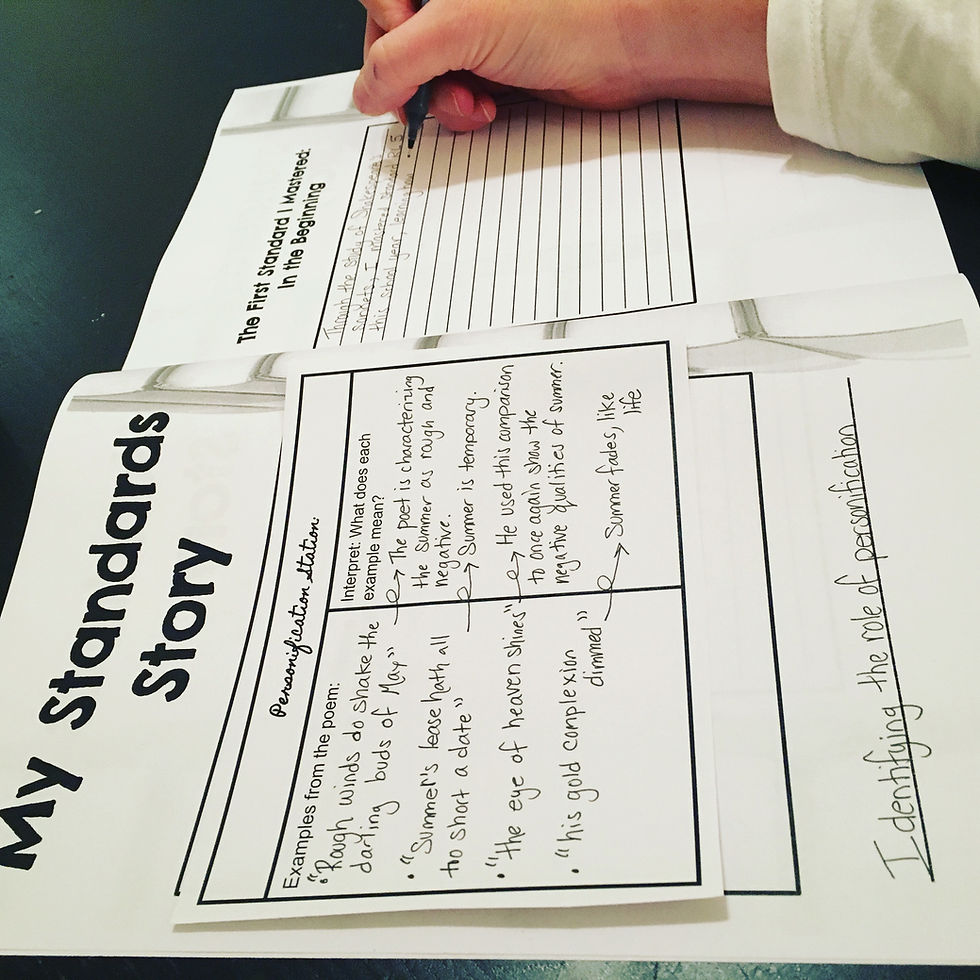Four Guidelines for Making Final Assessments Meaningful
- Emily Aierstok

- May 31, 2017
- 4 min read

Standards-based learning has transformed my classroom in many ways. This transformation is never more evident than final exam season. While many teachers still require their students to sit and take final exams in rows upon rows of desks in a silent gymnasium, my students' final assessment no longer looks anything like that. In fact, it is the polar opposite.
As my students work on their final assessments, my classroom fills with discussion of learning, standards, and growth. Students pull papers from the depths of their portfolios looking for evidence of their mastery. They compose and recompose, conference and adjust. My students spend the majority of their time at the end of the school year reflecting.
Students in my classroom have never been so challenged, and their final assessments have never been more meaningful. Making the shift from traditional testing to a standards-based final assessment was not easy; however, focusing on the following four guidelines gave me the direction I needed.
1. Make Final Assessments Standards-Based
Standards provide students and teachers with clear goals for learning and understanding. Final assessments should, in turn, provide evidence of students' mastery of these standards.
Too often, students are being measured against each other (remember bell curves and shifting of grades depending on how students performed after a test was given and student performance was measured?). Instead, final assessments should measure students against standards of learning required for that grade level.
2. Focus on Understanding
In a meaningful final assessment, students are demonstrating their understanding of a standard, not their memorization of facts or their ability to mimic a task.
For example, in 7th grade ELA, one of our "power standards" is standard RL/RI 1: cite evidence to support an analysis of a text. A meaningful final assessment will measure students' understanding of this standard. Students would demonstrate their ability to analyze a text and support that analysis with quotes or specific evidence from a text. There are a variety of ways that students could demonstrate their level of understanding: an essay, a project, even a conference with the teacher.
The key is not necessarily how the students demonstrate their understanding; the key is that they are able to demonstrate their understanding.
3. Require Evidence of Learning and Growth
Just because students are not sitting quietly in rows taking a fill-in-the-bubble test does not mean they are not held accountable; if anything, when students are asked to demonstrate their understanding of standards, they are often challenged more and reach higher levels of learning.
A meaningful final assessment holds students accountable for their learning with evidence. The burden of proof is on the students. Their work should prove their understanding, growth, and learning. Once again, the format of the evidence might change from one standard or one student to the next. They key is that the evidence of learning is there.

4. Make it Reflective
John Dewey claimed, “We don’t learn from experience. We learn from reflecting on experience.” The act of reflecting on learning is learning. Reflection requires higher level thinking skills that filling in the bubbles of a multiple choice exam cannot necessarily provide. Making a final assessment that is reflective requires students to identify and be aware of their own learning and growth.
There is rarely time to reflect on learning during the school year, especially during a 40 minute class period, and especially when the end of the school year is sneaking up on you. However, making a final assessment that is reflective gives students the opportunity to gain awareness of their own learning and allows them to set goals for the future.

What does a meaningful final assessment look like in practice?

This week, my students are working on an end-of-year project called "My Standards Story." Each individual student reviews the work he or she has completed during school year which is compiled in a portfolio. Using their work as evidence, students reflect on their learning and growth by telling the story of the standards they have mastered and the standards that have challenged them the most.
"My Standards Story" is not only reflective and focused on growth, learning, and standards, it is also students' last argument. Students must state a claim about their learning of the standards and prove their claim using their work as evidence.
Students' standards stories are more meaningful than any traditional exam I've administered in the past. As students work on developing their standards stories, I have the opportunity to witness great ah-ha moments and moments of self-awareness. I also feel confident as a teacher that asking my students to prove their understanding using their work as evidence is the most accurate measure of their learning.
As education shifts to a more standards-based approach to learning, our final assessments must follow. Assessments that are standards-based, focus on understanding and reflection, and require evidence of learning are more meaningful than traditional exams. As teachers, there is nothing more rewarding than witnessing our students' growth, learning, and understanding. A meaningful final assessment will provide us with that experience.
.png)



